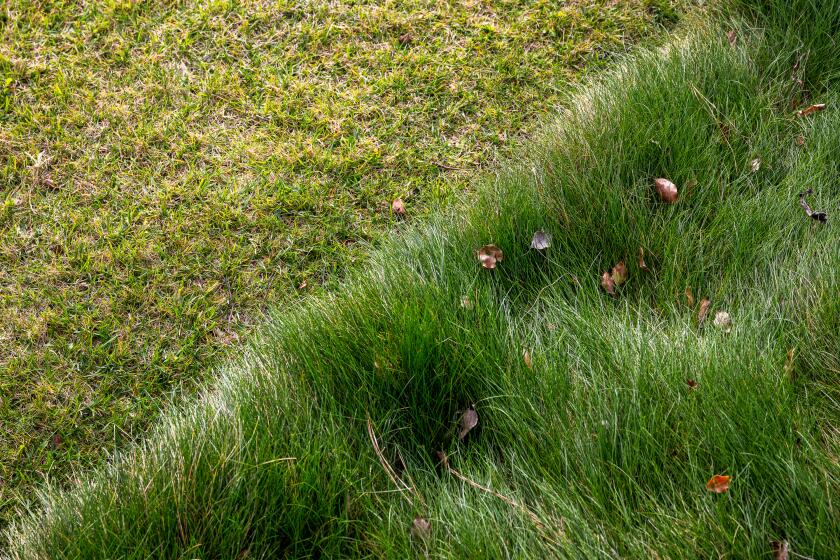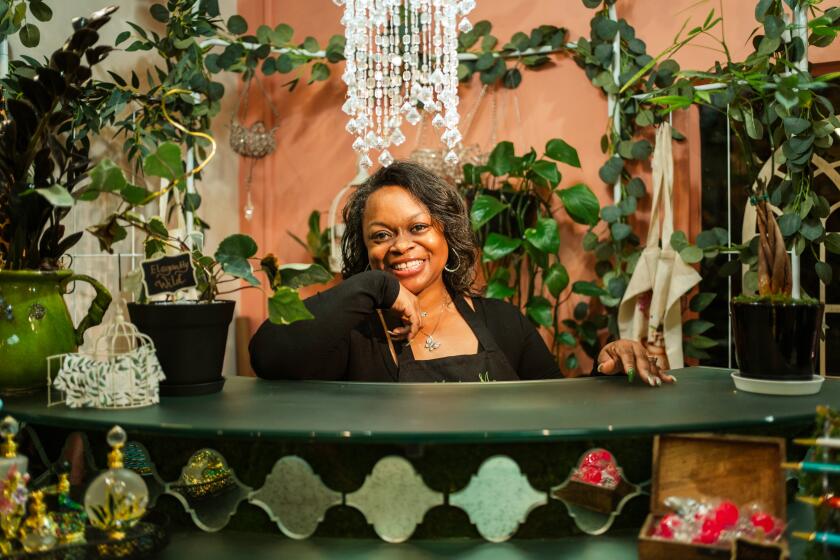Desert farmers share their best tips on how to grow food in hot, dry conditions

If you’re a Southern California gardener planning to grow food this summer, it’s time to pay attention to how they grow veggies in the desert, because July, August and September will likely be HOT.
Yes, I know, it’s been and continues to be a record-setting wet and chilly spring, but starting in June, the National Oceanic and Atmospheric Assn’s National Weather Service expects most of the country to have higher-than-average temperatures for the rest of the year.
In Los Angeles, the average high in August is 85 degrees. If we’re going to have lots of days above that, with the promise of more expensive water rates coming this year and next, you’d better start thinking now about how you’re going to keep your tomatoes and other veggies from perishing in the heat.
There’s a questionnaire about the etiquette of taking someone else’s fruit down below, along with lots of plant-related activities for May, but first I want to share what I learned from two desert gardeners/farmers, horticulturist and author Maureen Gilmer, who lives in the Morongo Valley, and Faultline Farm manager Josh Nash of Twentynine Palms.
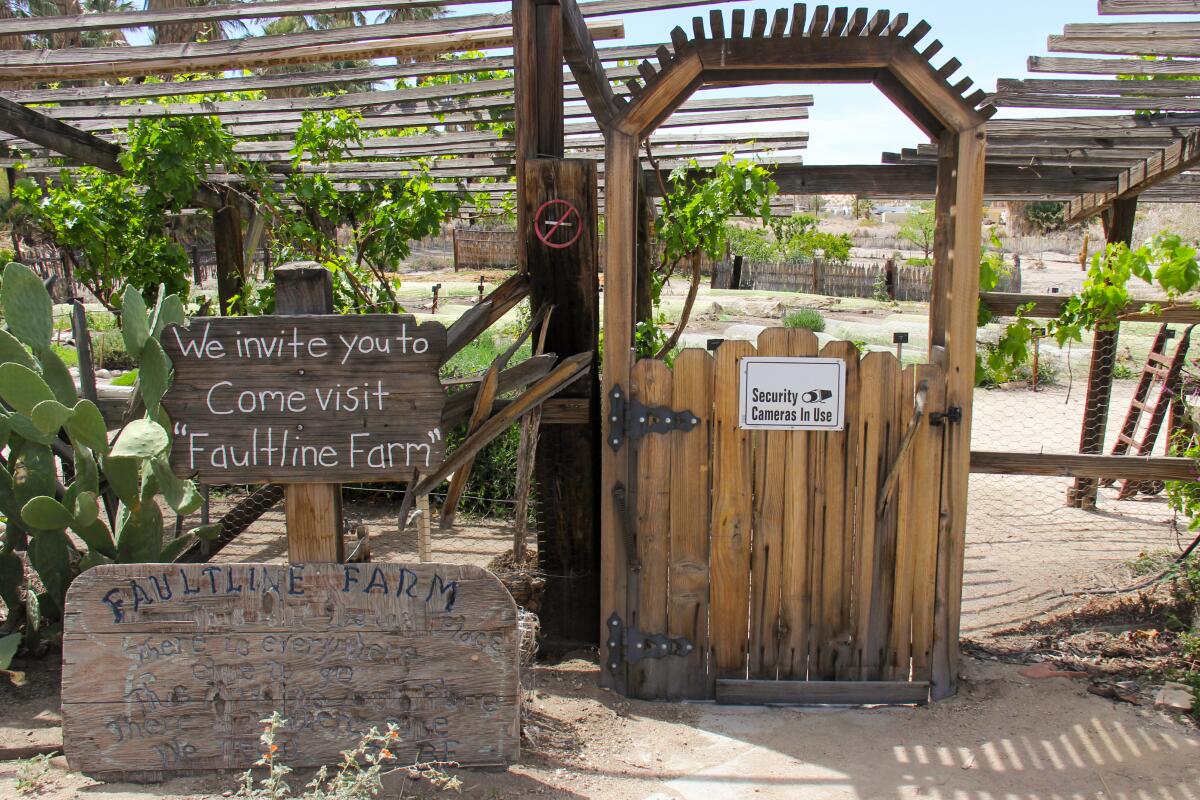
Gilmer wrote a book about dry, hot farming in 2015 (“Growing Vegetables in Drought, Desert, and Dry Times: The Complete Guide to Organic Gardening without Wasting Water”) and Nash, a native Tennessean who learned about farming on the East Coast, has been growing organic fruit and vegetables in the desert for five years, at his home and also for the historic 29 Palms Inn’s Faultline Farm, which provides about a third of the produce for the inn’s popular restaurant every year, said owner Heidi Grunt.
Sign up for our L.A. Times Plants newsletter
At the start of each month, get a roundup of upcoming plant-related activities and events in Southern California, along with links to tips and articles you may have missed.
You may occasionally receive promotional content from the Los Angeles Times.
Bottom line for hot, dry farming: Be stingy with water via drip irrigation, toughen up your plants and above all else, baby your soil.
Obviously, you can’t grow food without water, but you really can’t grow food in sterile soil — that is, soil where all the organic nutrients have been sucked dry, said Gilmer and Nash. In the desert, it doesn’t take long for soils to get depleted by the sun and wind, which desiccates plants by stealing their moisture and nutrients.
That’s why Nash advocates covering your soil at all times — with row covers, thick layers of mulch (he uses chipped palm fronds) or a living mulch like mint (which he grows under his fruit trees) or hairy vetch, fava beans or peas, which have the advantage of also adding nitrogen to the soil.
“People need to realize that growing plants actually means growing soil,” Nash said, “because you can’t grow any plants without healthy soil, first and foremost.”

Vegetables, especially flowering and fruiting warm-season crops like tomatoes, peppers, eggplants, cucumbers and squash, need lots of nitrogen to produce, said Gilmer, so regularly feeding your soil is absolutely paramount.
“Soils must be very fertile to grow annual vegetable crops,” she said. “Those plants require a tremendous amount of nutrition to germinate, flower and fruit in a few months time, and if they’re lacking nutrition their immunity goes down and that’s when the pests come and infest the plants, because they know they’ve lost their natural defenses. You can keep watering the plants at that point, but they don’t need water. They’re dying because they’re starving.”
Tearing out your lawn but still want a swath of green? Try planting water-saving (and labor-reducing!) California native grasses instead.
Fertile soils are also better at retaining water, said Nash, and encouraging the beneficial creatures like earthworms, pill bugs and microbes that keep the soil healthy.
Manure teas, kelp or fish emulsion can feed plants, but Gilmer advocates for adding plenty of composted steer manure to her garden beds every year to boost their nitrogen content and microbial activity.

Nash prefers growing cover crops like hairy vetch during the winter and spring to draw nitrogen into the soil. By mid-spring, when the plants are spent, he chops them up and uses them as mulch on his garden beds, a kind of “composting in situ,” he said. “I just chop and drop them right there.”
He uses mint all year around the base of the farm’s fruit trees. The mint’s dense root system would compete too vigorously with vegetables in garden beds, he said, but it helps keep the soil cool and nourished under more deeply rooted fruit trees, and it only grows in areas where it gets water.
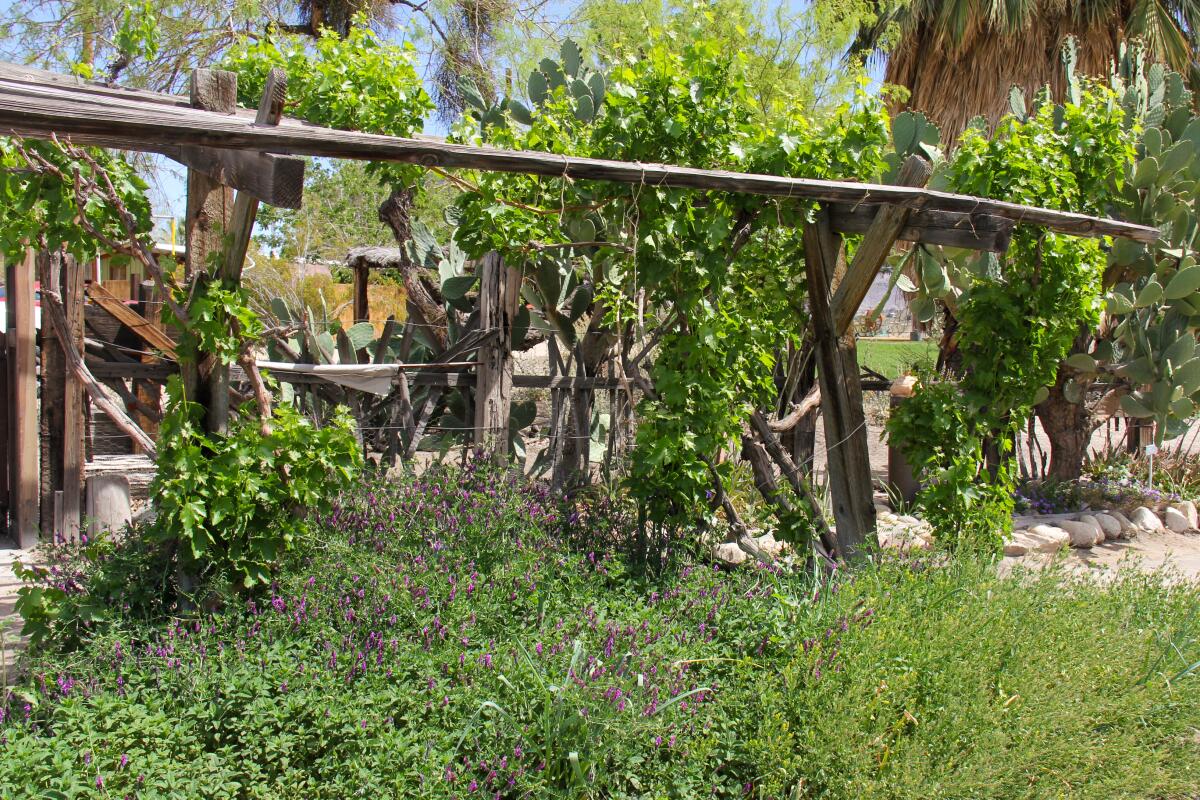
Here are some of their other tips for beating the heat and keeping their vegetables alive:
- Plant in the ground whenever possible. Wood-frame raised beds work well in areas that are colder, because they help the soil get warmer quickly, but that’s the opposite of what you want in hot, dry conditions. “Not only will raised beds overheat, but the wind and sun will dry out the soil on the periphery really quickly,” Nash said. “We make our beds directly in the soil, a few inches lower than the ground level to help catch and hold any precipitation, and keep the roots cooler.” An added bonus: Even the most damaged native soils have some microbial life that you can help nourish with compost.
- Metal feeding troughs make disastrous vegetable beds, for all the reasons listed above, Gilmer said. “In hot weather, the metal just fries the roots,” she said, and the containers provide no insulation for plants when the weather turns cold.
 Tulle, used for covering garden beds, sits in a pile next to a purple-flowered borage plant that attracts plenty of pollinating bees.(Jeanette Marantos / Los Angeles Times)
Tulle, used for covering garden beds, sits in a pile next to a purple-flowered borage plant that attracts plenty of pollinating bees.(Jeanette Marantos / Los Angeles Times) - Whenever possible, grow directly from seed rather than transplants. That will allow the plants to adapt to the high heat more readily than seedlings grown elsewhere, Nash said. He recommends growing a variety of non-hybridized vegetables to see which fare best in your garden and saving the seed from the tastiest plants that grow best for next season’s crop.
- Choose seeds or plants adapted to hot, dry climates and plant seasonally. If you try to grow cool-season crops like lettuce during the hottest months, “the plants will grow, but they won’t do what you want them to do,” Nash said, because the heat will make them go to seed almost immediately and turn bitter. And warm-season plants like tomatoes, pumpkins and eggplant likely won’t get warm enough to ripen any fruit.
- Use row covers to protect young plants from the wind and sun. Gilmer likes geo-textile covers but Nash said those fabrics don’t work well at the farm. “They just get ripped up by the wind,” he said. Instead they use rolls of porous tulle fabric and then add loose-weave jute netting over the top to provide additional shade in the afternoon, when the sun is most fierce.
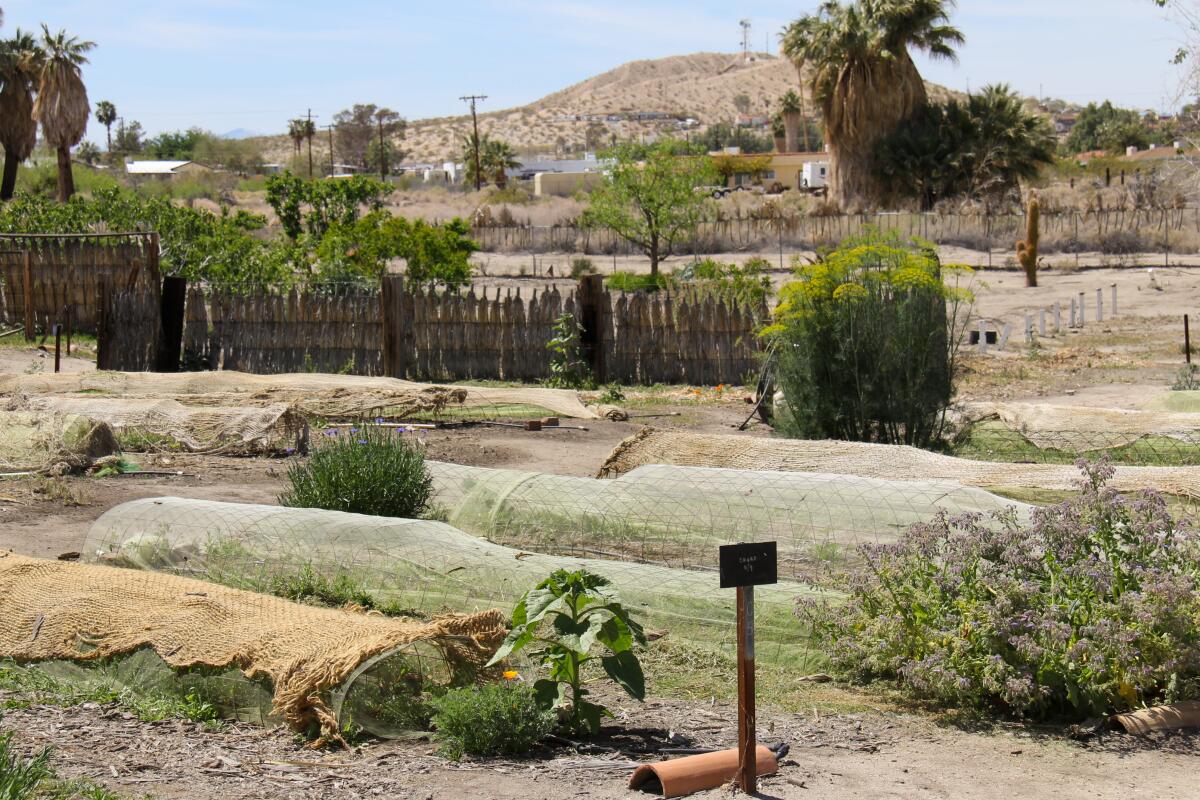 Green tulle covers rows of young plants, protecting them from wind and sun, along with a few rows also covered with loose-woven jute netting.(Jeanette Marantos / Los Angeles Times)
Green tulle covers rows of young plants, protecting them from wind and sun, along with a few rows also covered with loose-woven jute netting.(Jeanette Marantos / Los Angeles Times) - Mulch, mulch, mulch, using whatever natural materials you have around you, from fallen leaves to chopped-up cover crops. Nash said even weeds like the invasive black mustard covering SoCal’s hills can be cut and laid down in garden beds to create an excellent mulch — as long as it hasn’t formed any seeds. Faultline Farm produces tons of palm fronds from the palm trees circling its small oasis. They stack the fronds after they fall and then hire a chipper once or twice a year to create piles of frond-chip mulch.
- Push your plants to drink deeply but infrequently. When it comes to allocating water, first and foremost, keep your trees alive, Gilmer said, because they are the most difficult to replace and they help keep your property cool. Nash said he waters the farm’s fruit trees in the hottest months with a slow-running hose every week to 10 days, moving the hose every hour or so. Young vegetables get water every few days, until they’re established, but once they’re mature, Nash said he tries to water them as infrequently as possible to encourage their roots to dig deep for moisture in the soil. In the heat of summer, he’ll let his drip lines run for 45 minutes to an hour on his mature tomatoes and then wait a week to 10 days to water again. “Always check first, before you water, to see if the soil is dry,” he said. “Push your plants a little bit, because once they’re big, it’s to your disadvantage to baby them too much.”
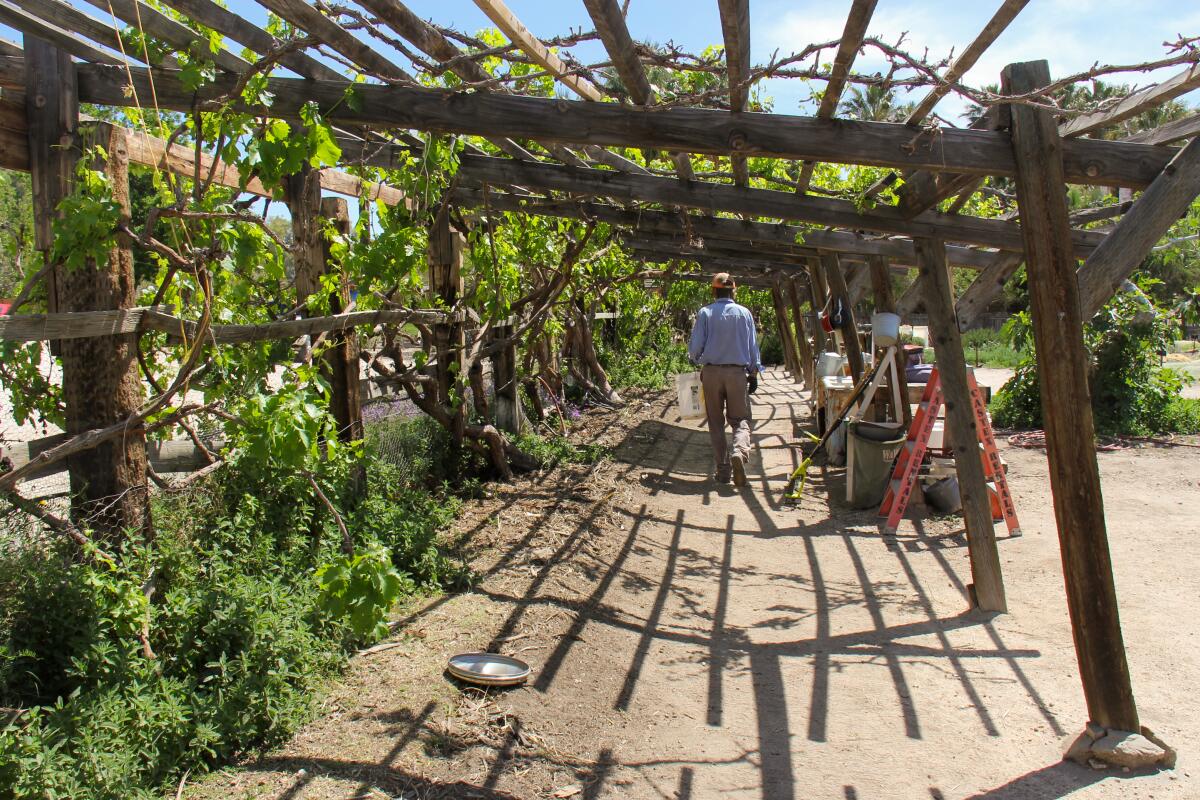
- Visit your garden daily. “Eventually you’ll get to the point where you develop an intuition with your plants,” Nash said. “You start talking to them, and before you know it, they’ll be talking back to you.”
Advice please
Anyone who takes a walk on Southern California streets can’t help but notice the abundance of fruit trees, especially citrus, and the huge quantity of fruit that never seems to be picked.
I’m working on a story about what to do with tree fruit when you have more than you can use — suggestions are always welcome! — but I also have some etiquette questions: When is it OK to help yourself to fruit from someone else’s tree?
Clearly we shouldn’t walk into someone’s yard and just start picking, but what if the fruit is dangling from the branch on your side of the fence? What if it’s hanging over an alleyway fence or into a public street or sidewalk?
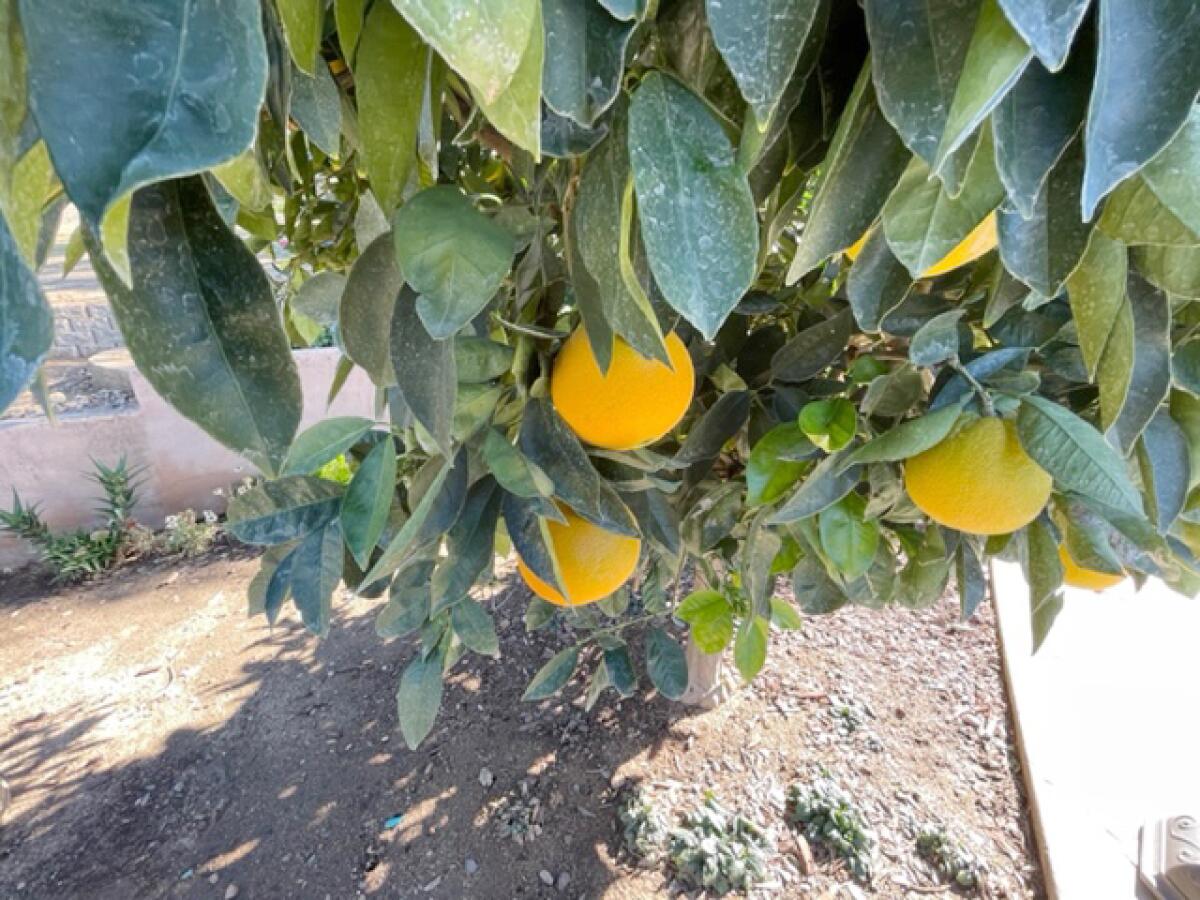
And what’s the etiquette for picking up fallen fruit? Is it OK to pick up oranges or lemons lying in the gutter or on the sidewalk? What if they’re in a yard within easy reach from a public street and clearly being left to rot? Should you knock on the door and ask permission or just help yourself?
Take our survey and let us know when you think it’s OK to grab fruit from someone else’s tree. Your answers may be featured in an upcoming edition of our Plants newsletter.
Readers, tell me what you think by filling out this form by Mother’s Day, May 12, and I’ll write up your responses in an upcoming newsletter. Note: Your responses will be used in aggregate. We ask for your name and email in the survey, but only to follow up with questions for our article. We won’t use your name in the story unless you give us permission.
Consider subscribing to the Los Angeles Times
Your support helps us deliver the news that matters most. Become a subscriber.
Upcoming events
May 2
Managing Pests in Your Garden, a UC Master Gardeners of Orange County lesson in outsmarting bad insects and attracting beneficial insects to your garden, 1 to 2 p.m. at the Norman P. Murray Community Center in Mission Viejo. The class is free but registration is required. mgorange.ucanr.edu
May 3
Coldwater Canyon Betty Dearing trail restoration, 9 a.m. to noon at the TreePeople park in Beverly Hills. Volunteers will help remove invasive species, maintain the trail to prevent erosion and wildfires and plant native plants. The event is family friendly; volunteers who are 15 or younger must be accompanied by adults 21 or older. treepeople.org
May 4
South American Bromeliads in Nature, a presentation by Dylan Zoller, caregiver of the Sherman Library & Gardens’ bromeliad area, for the San Fernando Valley Bromeliad Society, 10 a.m. to 1 p.m. at the Sepulveda Garden Center in Encino. Admission is free for first-time guests, annual membership for the society is $20. sfvbromeliad.homestead.com
May 4-5
California In My Garden: Orange County Chapter of the California Native Plant Society’s 2024 Garden Tour, from 10 a.m. to 4 p.m. both days, in the southern section of Orange County on May 4 and the northern section on May 5. Participation is free, but you must register in advance to sign a waiver and get directions to the garden locations. chapters.cnps.org
It’s taken a decade, but Raul Rojas and Thomas Zamora have turned a Highland Park yard of hard dirt and junked cars into a lush expanse of native plants, succulents and vegetables.
Sunset Succulent Society Cactus & Succulent Show & Sale, noon to 4 p.m. on May 4 and 9 a.m. to 4 p.m. on May 5 at the Veteran’s Memorial Complex Teen Center in Culver City. Admission is free. sunset77.wixsite.com
May 4, 8
Wildflower Adventure Hikes, 10 a.m. to noon in Simi Valley both days, tours conducted by naturalist Laura Pasetta of Wild Rootz using field guidebooks and phone apps to safely identify local wildflowers. The May 8 hike includes information about medicinal and culinary uses of North American wildflowers. Register online, $35. wild-rootz.com
May 5
South Coast Chapter of the California Native Plant Society tour of the Westwood Neighborhood Greenway led by Climate Reality Project Ambassador Charles Miller, 10 a.m. to noon at the Westwood Neighborhood Greenway in Rancho Park. Attendees can stay and help with a volunteer day to remove invasive weeds. chapters.cnps.org
Long Beach Cactus Club Show & Sale, noon to 4 p.m. at the Women’s Club of Bellflower in Bellflower. longbeachcactusclub.org
Barbara Lawson used gardening to pull herself out of depression. Now, she’s sharing the healing powers of plants with others at her South Bay plant shop.
May 10-11
Gates Cactus and Succulent Society 49th Show & Sale, 9 a.m. to 4 p.m. at the Redlands Church of the Nazarene in Redlands. Admission is free. gatescactusandsucculentsociety.com
May 11
Eating California, a class in California native foods and gardening with Antonio Sanchez, manager of the Santa Monica Mountains Fund Native Plant Nursery, 10-11:30 a.m. at Growing Works Nursery in Camarillo, which is also hosting a sale of native plants and succulents. The class is $18; admission to the sale is free. eventbrite.com
Santa Barbara Cactus & Succulent Society Show & Sale, 10 a.m. to 3 p.m. at the Santa Barbara Woman’s Club in Santa Barbara. Admission is free. sbcactus.org
Peck Park Canyon Native Plant restoration project spring maintenance work at the Elberon/Walker trailhead in San Pedro. Admission is free. facebook.com
Moms, Mums and Mimosas with Joan Stevens of Mamabotanica, 10 a.m. to noon in Pasadena. Learn how to grow heirloom chrysanthemums from cuttings while sampling mimosas and tea. Tickets are $60. mamabotanica.com
One of the easiest ways to learn about California native plants is volunteering to get your hands dirty. Here are some opportunities around Los Angeles, Orange and Santa Barbara counties.
May 11, 18
San Bernardino National Forest Green Thumbs volunteer restoration events, 9 a.m. to 3 p.m. in the national forest. Volunteers must register in advance to help with dispersing native seeds, planting native species and trail restoration work. fs.usda.gov
Learn Regenerative Gardening By Doing It Yourself at Arlington Garden, 9 a.m. to noon as part of the second Saturdays Weekend Workshops. Learn how to garden regeneratively with native and Mediterranean-climate plants by working in the soil at Arlington Garden in Pasadena, planting, landscaping, and learning to identify desirable plants and undesirable weeds. arlingtongardenpasadena.org
Nature Education Walk at Taft Gardens & Nature Preserve led by Lanny Kaufer of Ojai, author of Medicinal Herbs of California: A Field Guide to Common Healing Plants, from 9 to 11 a.m. in the preserve near Mira Monte. Directions will be provided upon registration, which costs $40. eventbrite.com
Family Night Hike: The Birds and the Bees, 5:30 to 7 p.m. at the Los Angeles County Arboretum. The program is designed to give children and families a chance to explore nature at the garden after dark. The class is $20 ($15 for members, and free for children under 12 months.) arboretum.org
May 11-12
Geranium Society Show & Sale, 9 a.m. to 4 p.m. at the Los Angeles County Arboretum in Arcadia. The show is free with $15 admission to the Arboretum ($11 students and seniors 62 or older, $5 children ages 5-12 and free to members and children 4 and younger). arboretum.org
May 11 and 12
Adult Night Hike: Floriography, the Language of Flowers, 7:30 to 9 p.m. at the Los Angeles County Arboretum in Arcadia. Learn about the Victorian era’s passion for floriography, the subtle art of communicating through flowers. Tickets are $25 ($20 for members). arboretum.org
Try something new on Mother’s Day. Skip brunch and treat Mom to a museum, hike, craft fair or comedy show instead.
May 16
San Gabriel Valley Orchid Hobbyists Annual Auction, 6 to 9 p.m. at the Los Angeles County Arboretum’s Ayres Hall. Admission is free. arboretum.org
May 17-18
Los Angeles Cactus & Succulent Society Cactus and Succulent Sale, 5 to 9 p.m. on May 17, 9 a.m. to 3 p.m. on May 18 at the Tarzana Community Cultural Center. Admission is free. lacactus.com
May 18
Floral workshop: Make Your Own Corsage, 2:30 to 4 p.m. at Sherman Library & Gardens in Corona del Mar. Learn how to create a modern corsage with all materials included. Tickets are $110 ($95 for members). thesherman.org
Ikebana Floral Design Workshop, 5:30 to 8 p.m., a workshop taught by South Korean floral designer and visual artist MangoMade. The class costs $100 and includes design equipment, flowers, drinks and snacks. usalproject.com
Plumeria A-Z, 10 a.m. to 1 p.m. at the Los Angeles County Arboretum in Arcadia, a workshop on the care, genetics and grafting of plumeria, taught by plumeria expert Diana Donnellan. Tickets are $40 ($30 members). arboretum.org
May 19
Epiphyllum Show & Sale, 9 a.m. to 4 p.m. at the Los Angeles County Arboretum in Arcadia. The show includes epiphyllum flowers (aka cactus orchids), flower arrangements and plants. The show is free with $15 admission to the Arboretum ($11 students and seniors 62 or older, $5 children ages 5-12 and free to members and children 4 and younger). arboretum.org
May 22, 23
Spring and Summer Planting in Southern California, classes taught by master gardener Yvonne Savio, creator of the Gardening in LA website, at the Vernon Branch Library on May 22 from 4 to 5 p.m. and Lakewood Garden Club in Lakewood on May 23 from noon to 1 p.m. Admission is free to both events. gardeninginla.net
May 25-27
Santa Anita Bonsai Show, 9 a.m. to 4 p.m. each day at the Los Angeles County Arboretum in Arcadia. The Santa Anita Bonsai Society will present trees trained to look like miniature forest giants. The show is free with $15 admission to the Arboretum ($11 students and seniors 62 or older, $5 children ages 5-12 and free to members and children 4 and younger) arboretum.org
Caverns in Laguna Niguel. A redwood grove in Brea. Scores of poppies in Anaheim. Hiking trails in O.C. deliver surprises for everyone.
May 29
Sunset Plant ID Hike, 6 to 8 p.m. at the Elysian Park Arboretum, a hike led by naturalist Jason Wise (aka jasonjourneyman) to identify local wild plants and animals. Tickets are $35. usalproject.com
Celebrating native plants at Festival of Books
L.A. Times Plants partnered once again this year with the Theodore Payne Foundation and the California Native Plants Society, and once again, our Festival of Books booth was inundated with people eager to learn more about native plants. Many thanks to the 660 visitors who signed up for this newsletter over the weekend. (Welcome!)
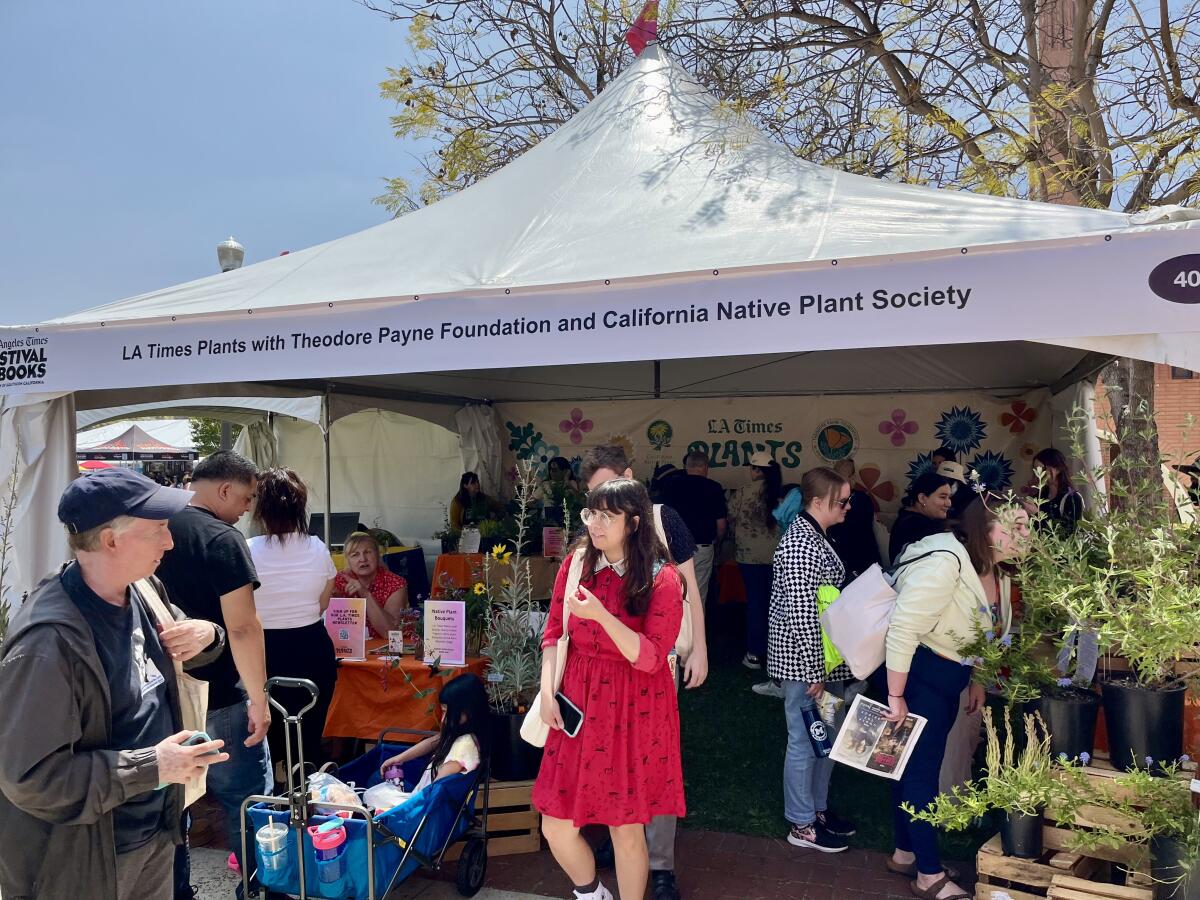
Additional thanks to the people who came to our Ask A Reporter talk on April 21 to find out more about creating bouquets from native flowers. Everyone (including me!) was pretty dazzled by the spectacular stems provided by the California Botanic Garden and Linda Prendergast, head of the garden’s volunteer flower arranging group Native Designs (see her in action in this video.)
We passed out hundreds of packets of our specially curated California wildflower seeds (eight different varieties). And every few moments someone new was sniffing the fragrant plants provided by the Theodore Payne Foundation to fill the booth. Meanwhile, the California Native Plant Society helped folks decipher which plants would work best for them based on their ZIP Code. We hope to do it all again next April!
Native plants don’t just provide color and habitat in our yards, they also create beautiful, long-lasting, fragrant bouquets with the right preparation.
What we’re reading
Once upon a time a Studio City couple bought a Storybook home with a sagging roof and dreary yard. Today the roof is fixed and their yard has been transformed into a native plant paradise.
The Carrizo Plain in eastern San Luis Obispo County is one of the state’s most iconic wildflower viewing areas, but is this year’s display worth the 150-mile drive from L.A.? It all depends on what you’re looking for.
Want to learn more about California native plants? Here’s a list of 18 organizations that let volunteers work with experts while rebuilding habitat and restoring invasive-weed-ravaged hills.
How do native plant nerds make music? Sage Against the Machine is an L.A. band of botanists who combine rap, metal, punk rock and even polka with sly, witty lyrics to express their passion for native plants.
Sign up for our L.A. Times Plants newsletter
At the start of each month, get a roundup of upcoming plant-related activities and events in Southern California, along with links to tips and articles you may have missed.
You may occasionally receive promotional content from the Los Angeles Times.
